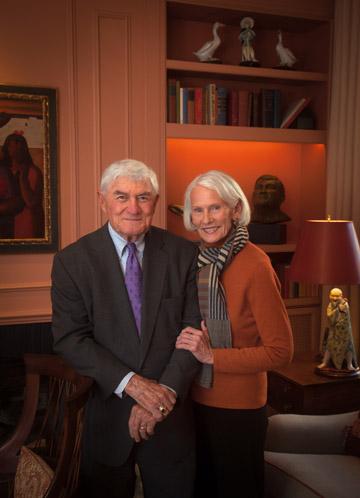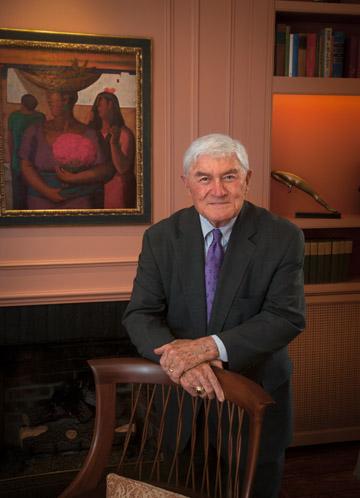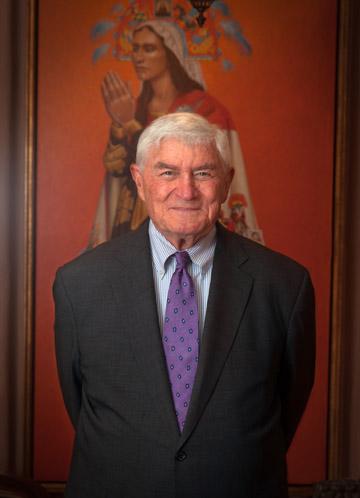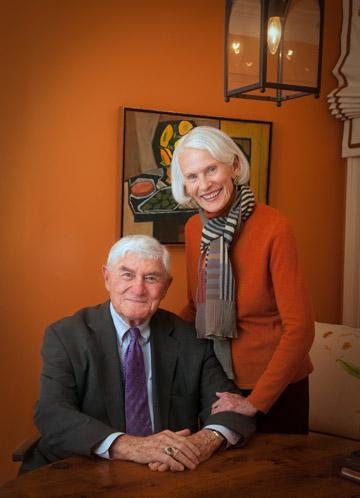Life & Times In Real Estate: Wes Foster
By • November 25, 2013 0 5845

Once upon a time in America, a boy left Georgia to become a Virginia Military Institute cadet, then a soldier, and later an aluminum siding salesman. He turned to selling real estate in Washington’s booming suburbs in the 1960s and now commands the largest privately owned residential real estate company in the United States. The story of P. Wesley Foster, Jr., is the story of 20th-century American success.
Foster is the chairman and CEO of Long & Foster Companies, headquartered in Chantilly, Va. His easy manner tells a tale of an American life we hope can still happen today. Georgetowner editors got a chance to sit down with the real estate legend.
As his executive assistant offered us coffee, Foster greeted us in his modest—at least by Donald Trump’s standards—office. The space immediately telegraphs his main loves — real estate, VMI, America, football, art, his family and especially his wife, Betty.
Feeling casual with Foster’s disarming charm, one of us flippantly began, referring to Long & Foster. “I know all about you guys.” Foster shot back, “I doubt it.”
No doubt, Foster has built a real estate and financial services empire step-by-step, agent-by-agent and office-by-office for longer than four decades. Who has not seen a Long & Foster sign somewhere during a daily drive? Such effort to build the top independent real estate company in America is not for the faint of heart, short of time or low of aim.
These days, however, Foster can take it a little easier: “I get up around 7 a.m. and read the paper,” he said. He doesn’t arrive at the office until just before 9 a.m. Foster and his wife—a sculptor who taught at the Corcoran and was on its board—moved to a townhouse in Old Town, Alexandria, after spending 32 years in their McLean, Va., home with almost four acres. “I go for a walk with my wife when the weather is good in the afternoons,” he continued. “So, I leave the office around 3:30 or 4 p.m. … I’ll be 80 in November. I don’t work as hard as I used to.”
Fair enough. He deserves that, although he still visits the branch offices and sales meetings as often as he can. In Foster’s early years, the opposite surely was the case. His long hours involved a six-day work week.
It’s this sort of discipline that Foster needed to build his company, but he has had some vices along the way. The first of which has been a sweet tooth. He manages his love for chocolate, and even turned to candy while he quit smoking when he was 30. “I was dating my wife and carried around a little bag of chewing gum and lifesavers,” he said.
As to the impact of the recent economic recession on the housing industry, Foster is clear. “We went through about five years of challenges in the market. Our production went down from 2005 to – I don’t know where the low point was, 2008 or 2009 . . . and now we are fortunate to see growth once again. As tough as it was to do, we continued investing in our company and our people. That’s what makes us so optimistic going forward.”
Not that Long & Foster itself was immune from such miscalculations. Its huge Chantilly headquarters building is an unexpectedly imposing Williamsburg-style building that has a similarly styled garage with more than 1,000 parking spaces, which Foster has dubbed “the best-looking parking garage in Washington.” He is pleased that the company has just negotiated a lease for 50,000 square feet and looks forward to welcoming new tenants to the building. “It’s a beautiful building and we are quite proud of it,” he said. “I think our headquarters represents the stability and confidence of our company and our agents.”
Still, the economy appears in recovery—with the stock market hitting an all-time high and unemployment numbers lowering March 8—but Foster remains cautious: “I’m not sure that it’s going to be that great [a recovery] because the Federal government has to get its house in order. The good news is that our company is well positioned to succeed in any scenario. I learned early on that if we lead our team to focus on the basics – really taking great care of every single client, one transaction at a time – then together as a team, we can weather any kind of market and emerge even stronger.”
Regarding the economy, Foster added: “We still have some work to do.” And as far as a true recovery in real estate? “We are working our way through and are beginning to see a real shift in the market.”
For Foster, such an approach illuminates his life. At VMI, he was on the football team. “My playing wasn’t that great,” he said. “But I played, played all four years. I was a slow, small guard.” Working his way through, even then. Foster has never truly left his beloved VMI. “I’m on the board there,” he said. “I go down there three or four times a year …” In 2006, VMI’s football stadium complex was dedicated as the P. Wesley Foster, Jr., Stadium.
So, what brought Foster to Washington, D.C., and specifically, its suburbs?
“When I graduated from VMI, I took a job,” Foster said. “I didn’t go directly into the military. You could take a year off and work in those days. So, I delayed my military duty for one year, and worked for Kaiser Aluminum. They put me in the Chicago office. When I got there I hated it. I mean, it was a place a little southern boy didn’t want to go to. But, by the time I left the next spring, I nearly left with tears in my eyes. I had a great time.”
Foster served his military duty as many young American men do and served for two years in West Germany. He was in the 8th Infantry Division—“Pathfinder”—and served as a special weapons liaison officer to the German III Corps. (Begun in World War I, this army division was inactivated in 1992.)
When his time was up, Foster said he toured Europe, thus igniting his love of travel. “They’d let you get out of the army over there and for up to a year, they would send your car and you home for free,” Foster recalled with a smile. “You could get out and travel if you wanted to. . . . Well, I got out, and a buddy and I … drove my Volkswagen to Moscow. The United States had an American exhibition that year and [Vice President Richard] Nixon was over there speaking. Got tears in my eyes watching him speak.” (This was the famous “kitchen debate” between Nixon and Soviet Premier Nikita Khrushchev in July 1959.)
Soon enough, our American GI returned home, with no money to his name. Foster got his old job back at Kaiser Aluminum and sold aluminum building products to homebuilders in 15 cities across the United States. Foster ran the program for a year. “Boy, did I get tired of that. I’d get up in the morning and have to think for a while about which city I was in that day.”
Nevertheless, one thing does lead to another. “All the guys I had been working with at Kaiser Aluminum got interested in the real estate business because we were working with builders, and I thought I’d become a builder,” he said.
This English major seemed still to be undecided on his career path. “I thought about law school,” Foster said. “My two brothers were lawyers, and had I never made it in real estate. . . . I would have probably gone onto law school and become a mediocre lawyer.”
So, why think that way and why the success in real estate? We asked.
“The guys that really tear it up are very bright. … I think I have a knack for this [real estate] business and see things that other people don’t see. In college, I graduated in the middle of my class. I may not have graduated at the top of my class, but I think I was the most persistent and worked the hardest – that’s what, after all of these years, has driven the growth and success of Long & Foster.”
Foster admitted that he sees “opportunities that other people don’t pick up,” and said a large part of his success was due to the “companies we acquire, and the people we hire and team up with. We choose to associate with people that share our values – teamwork, integrity and a drive for results. A team like this can be magical.”
Before that powerful recognition was a beginning: “I happened to meet a young fellow by the name of Minchew, who was also from Georgia and was a good builder here in Northern Virginia,” Foster recalled. “I went to work for him selling his homes. Worked for him for three years.”
Foster lived in Annandale, “sold a lot of new houses . . . and met my wife here,” he said.
“I had a roommate at VMI who was a Navy SEAL doctor and had come to Washington to do his deep sea diving training, if you can believe it, at Andrews Air Force Base,” Foster said. “He went skiing one weekend and rode up the ski lift with a pretty girl who became my wife. He introduced me to her and said, ‘Man, I’m leaving town, call her.’ ”
From Connecticut, Foster’s future wife moved to Virginia to be near her brother, an Episcopal priest. “We raised our family right here in Virginia,” Foster said. He is a father to three, and now a grandfather to six, ranging in age from teenagers to a four-year-old, all boys, and all of whom he takes delight, especially the youngest.
Today, of course, some of the family is involved in the business: son Paul Foster looks after offices in Montgomery County and D.C.; son-in-law Terry Spahr runs the New Jersey and Delaware offices; and nephew Boomer (Larry) Foster oversees offices in Northern Virginia and West Virginia. “Even as a large company, it’s important that we remain a family company. That way, our commitment to our agents and their success is unwavering,” Foster said.
Before all these company positions were possible, Foster had to meet Long. While working in Annandale on a new development, called “Camelot,” a name which Foster still dislikes to this day, he met Henry Long, an Air Force bomber pilot. The two worked together in a firm and then decided to start their own. And what of those good-looking homes in “Camelot”? They sold very well despite that name.
“We both went to military schools,” he said of Long. “He went to VPI [Virginia Tech]. I’d gone to VMI. He had flown B-47s. I shot rockets. He was commercial, and I was residential. We’d start a company, and we flipped a coin. He won and got his name first. I got to be president. We took off. We were partners for 11 years until 1979. Merrill Lynch came along and wanted to buy us, and he wanted to sell and basically do what he was doing and that was being a developer. So, I bought him out of the company.”
Foster has been asked the question again and again. We asked again, too, if he would sell the company. He folded his arms, leaned back and said: “I don’t want to sell . . . We have brought together some of the best business minds from inside and outside real estate to take our firm to the next level, and that gives us a solid succession plan as a family-owned company. Not many firms like ours can say that.”
“Family members play an instrumental role in the company,” Foster said. “I’ll be a large part of this as long as I can, but my three children own practically all of the company now. So, that’s all set. They will keep the family company spirit and leverage our management team to make sure we are on the right path.”
Things may be set internally, but elsewhere, competition remains for Long & Foster. In one of the nation’s hottest residential markets, that’s a given. “Good competitors drive us to better ourselves every single day,” Foster said. “It’s a great incentive to stay on top of your game and advance your business.”
“For example, luxury real estate, particularly in the D.C. area, is huge. Everyone out there today is vying for luxury business – and while we do sell more million-dollar-plus homes than anyone, our competitors keep us on our toes. That’s why we leverage our affiliation with Christie’s International Real Estate for our agents and their clients. The Christie’s brand really matters – it’s immediately recognizable as ‘high end,’ and it gets us in front of the most exclusive buyers and sellers from around the globe. Only our agents can market with the Christie’s brand.” Indeed, the biggest D.C. sale in 2011—the Evermay estate in Georgetown – was sold by Long & Foster.
How do you deal with all the egos? We asked. “The best you can,” Foster wryly replied. “We give them all of the tools and the backing of a great brand – and they do what they do best – work with buyers and sellers.”
“I will tell you this,” he said. “What we look for, especially in managers, is good empathy and a drive for results. When we achieve this, it is a winning combination for our company, and most importantly, for our agents and their clients. That is the key.”
From start to finish, Foster can easily detect that. “I grew up fairly poor and went to college on a scholarship, and my brothers also went to college on scholarships,” he said. “We’ve had a fair amount of drive. Two were lawyers and one is a developer now in Atlanta. I am truly humbled by the success of the company and my team. It is an honor that so many clients put their trust in Long & Foster and our team of agents.”
At a Glance:
Long & Foster is the largest independent residential real estate company in the United States.
Long & Foster represents more than 10,000 agents at approximately 170 offices across seven Mid-Atlantic and Northeastern states, plus the District of Columbia.
For 2012, Long & Foster’s sales volume exceeded $24.8 billion and with more than 74,000 transactions; this is up from $22 billion and 69,000 transactions in 2011. 2012 marked a year of significant growth for Long & Foster, seeing an increase in volume of 14 percent and a 9-percent increase in unit sales.
While Long & Foster was founded as a real estate company, today its family of companies offers everything customers need as it relates to buying selling, or owning real estate – including mortgage, insurance, settlement, property management and corporate relocation services.
Long & Foster Companies’ combined sales volume and equivalents for 2012 were $48.7 billion, a $6-billion increase from 2011 figures.
- Wes and Betty Foster | Philip Bermingham
- Philip Bermingham
- Philip Bermingham
- Philip Bermingham





